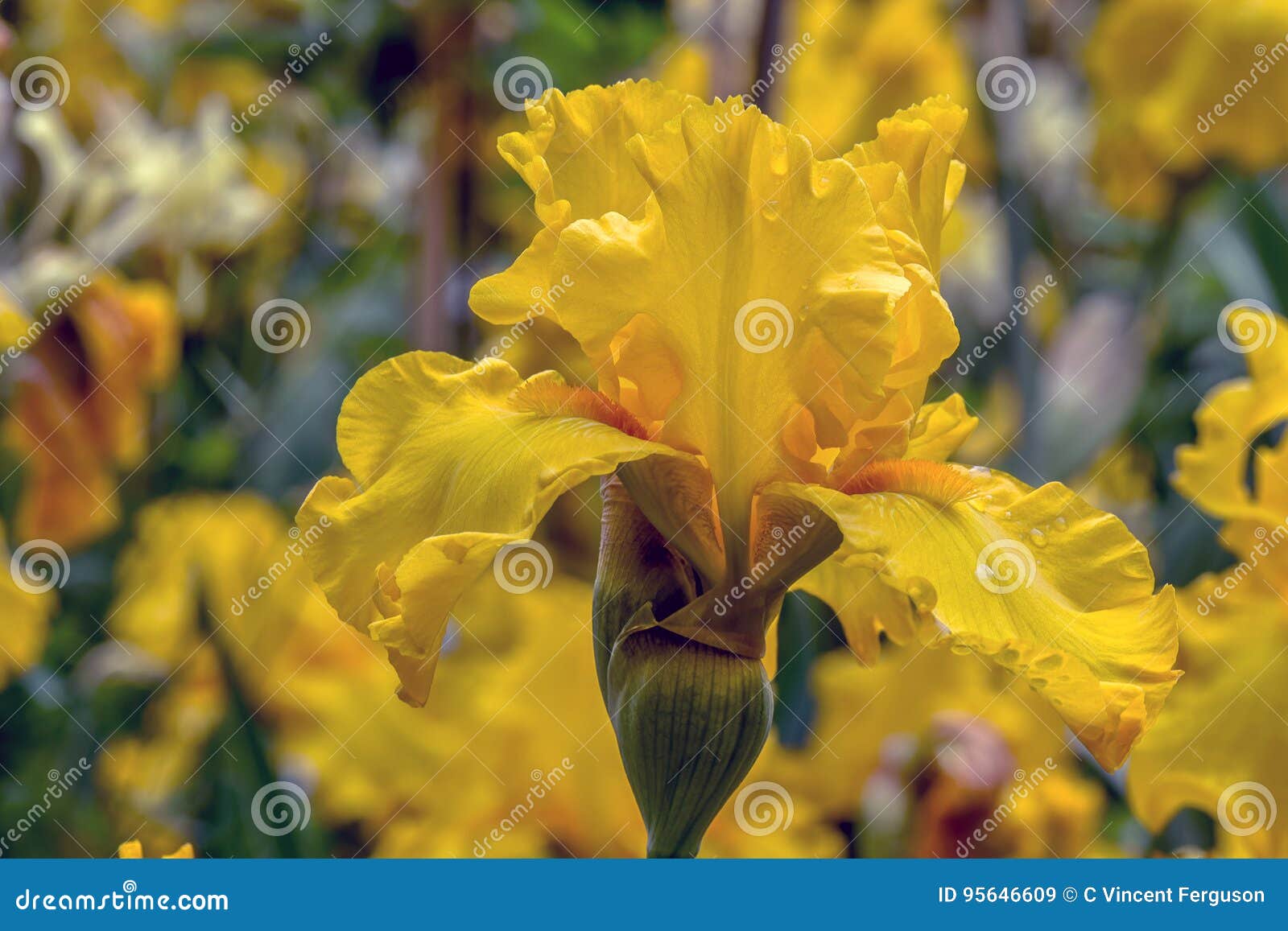The tall bearded iris cultivar ‘Here Comes the Sun’ is a golden vision of floral elegance. With its bright yellow petals and sunny disposition, this iris lives up to its name and provides a warm glow to any garden. In this article, we will explore the origins, growing conditions, and stunning beauty that have made ‘Here Comes the Sun’ iris a favorite for iris enthusiasts and gardeners.
A Hybrid with Impressive Lineage
‘Here Comes the Sun’ iris was hybridized by the renowned Schreiner family at their iris breeding facility and gardens in Oregon. The Schreiners have been leaders in iris hybridization since the 1920s, consistently introducing award-winning tall bearded iris cultivars. ‘Here Comes the Sun’ debuted in 2007 and is already making its mark by garnering an Honorable Mention from the American Iris Society in 2010.
This impressive iris combines genetics from two previous Schreiner introductions – ‘Yukon Fever’ and ‘Orange Blossom Special’. ‘Yukon Fever’ features bright golden yellow standards and falls while ‘Orange Blossom Special’ boasts tangerine standards and ruby red falls. By crossing these two cultivars the Schreiners have produced an iris with saturated golden yellow petals that seem to capture sunlight in every flower.
Growing Conditions for Optimal Performance
‘Here Comes the Sun’ iris performs best in full sun exposures, though it can tolerate partial shade Well-drained garden soil with a near neutral pH between 61-8.5 is ideal. While tolerant of short periods of drought once established, these irises produce their best flowers with consistent moisture. Shelter the rhizomes from excess winter wetness.
In USDA Hardiness Zones 4-8, ‘Here Comes the Sun’ can be grown as a perennial and is cold hardy to temperatures as low as -30°F (-34°C). Provide winter mulch in colder climates. Hot and humid summers are tolerated so long as the soil drains well.
With excellent heat and humidity tolerance, ‘Here Comes the Sun’ also thrives in Zones 9-10 as long as it is grown as an annual or dug up for storage over winter. In the hot and humid Deep South provide afternoon shade and extra water during summer dry spells.
Striking Flowers Uplift the Late Spring Garden
Under optimal conditions, the first blooms of ‘Here Comes the Sun’ iris open in late spring about mid-season for tall bearded irises. The bloom period extends for several weeks with reliable spring rains or irrigation. Each stalk bears 3-4 buds that open into flowers with velvety petals in luminous yellow.
The standards rise tall and straight above the falls. Both standards and falls feature gentle ruffles that add texture. The beards provide a warm orange accent. Flowers are nicely held on sturdy 36 inch tall stems. Light fragrance completes the delightful effect. The profuse bloom display and multi-branching form create bold clumps over time.
An Ideal Choice for Sunny Yellow Color Effects
With its bright golden blossoms, ‘Here Comes the Sun’ iris provides cheery color in the late spring landscape. Use en masse for bold drifts of sunlight, or pair with cool blues, whites, and purples for striking color contrast. This sun-loving iris is ideal around rose gardens, perennial borders, and pool plantings. For maximum impact, display near walkways where the flowers can be admired up close.
In warmer zones, new foliage remains evergreen through winter. The sword-shaped leaves form an attractive backdrop through the growing season. Plant with low-growing annuals and perennials to highlight the flowers held atop the leafy clumps.
A Reliable Rebloomer in Mild Winter Climates
Tall bearded irises are known to provide a spring spectacle of bloom followed by months of green foliage. One of the virtues of ‘Here Comes the Sun’ iris is its ability to rebloom, especially in Zone 9 and warmer. With sufficient water and sunshine, a second round of golden blossoms often appears in late summer and fall.
To promote reblooming, promptly remove faded flower stalks after the initial spring bloom period. Apply a balanced fertilizer every 4-6 weeks and keep the soil moist. Providing some afternoon shade can also boost rebloom. In regions with harsh winters, mulch the rhizomes for added cold protection to maximize spring and rebloom potential.
A Sun-Loving Iris Worth Adding to Your Garden
From its illustrious breeding background to its stellar performance in the garden, ‘Here Comes the Sun’ iris has quickly become a favorite of iris growers and gardeners. If you have a sunny spot in your landscape and want to bask in the glow of golden yellow blossoms this spring, look no further. Let this cheerful and resilient tall bearded iris brighten up your garden with a warm touch of sunlight in every flower.
Oops! Looks like we’re having trouble connecting to our server.
Refresh your browser window to try again.
Using an ad blocker?Some sellers use ads to promote unique inventory you might like. Turn off your ad blocker so you don’t miss a thing.Here’s how:
- Locate the ad blocker icon in your browser. It’s often in the top right corner.
- Select “Exclude” or “Disable” for eBay
- Refresh the page
Beatles – Here comes the sun (cover by Iris)
FAQ
What month is best to plant irises?
Do iris plants need full sun?
Do iris plants spread?
Who sang “Here Comes the Sun” other than the Beatles?
- A Complete Guide to Caring for Yuki Cherry Blossom Shrub - January 23, 2025
- Identifying Red Hot Poker Seeds: What to Look For When Harvesting Torch Lily Pods - January 23, 2025
- A Complete Guide to Harvesting Evening Primrose Seeds - January 23, 2025

